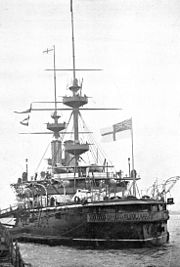| QF 3 pounder Hotchkiss | |
|---|---|
 Typical Royal Navy deck mounting, 1915 | |
| Type |
Naval gun Coast-defence gun |
| Place of origin | France |
| Service history | |
| In service | 1886 - 1950s |
| Used by |
|
| Wars | WWI |
| Production history | |
| Designed | 1885 |
| Manufacturer | Hotchkiss et Cie |
| No. built | 2,950 (UK) |
| Specifications | |
| Barrel length | 74.06 inch (1.88 m) bore (40 cal) |
|
| |
| Shell | Fixed QF. Shell 3.3 lb (1.5 kg), steel shell, common lyddite |
| Calibre | 47-millimetre (1.850 in) |
| Breech | vertical sliding wedge |
| Rate of fire | 30 / minute[1] |
| Muzzle velocity | 1,873 ft/s (571 m/s) |
| Maximum firing range | 4,000 yards (3,657 m) |
The QF 3 pounder Hotchkiss or in French use Canon Hotchkiss à tir rapide de 47 mm (47mm / L40) was a light 47-mm naval gun introduced in 1886 to defend against new small fast vessels such as torpedo boats, and later submarines. It was also used ashore as a coast defence gun and later occasionally as an anti-aircraft gun.
French service[]

United Kingdom service[]
United Kingdom History[]

In 1886 this gun was the first of the modern QF artillery to be adopted by the Royal Navy as the "Ordnance QF 3 pounder Hotchkiss",[2] built under licence by Elswick Ordnance Company.
By the middle of World War I the Hotchkiss gun had become obsolescent, and was gradually replaced in its class by the more powerful Ordnance QF 3 pounder Vickers gun. The gun's availability, simplicity and light weight resulted in its continued use in small vessels, and many were later brought back into service on merchant vessels used for auxiliary duties in World War II, or as subcalibre guns for gunnery practice until the 1950s. Early in WWII it was also pressed into service in ports around the British Empire, to defend against possible incursions by motor torpedo boats until the modern QF 6 pounder 10 cwt gun became available in numbers for that purpose.
United Kingdom ammunition[]
Australian service[]
A 3-pounder Hotchkiss was used on an improvised mounting in a battle that resulted in Australia's first prisoners of World War 2 being captured in 1940 near Berbera.
The guns are now used in a Three Pound Saluting Gun Battery at the Garden Island Naval Base.[3]
Russian service[]
47 mm Hotchkiss guns were used during the Russo-Japanese war and showed inefficiency against Japanese torpedo boats.
US service[]
|
|
This section is empty. You can help by adding to it. |
Polish service[]
47 mm Hotchkiss guns, designated as wz.1885 gun, were used on first ships of the Polish Navy, received after World War I, like ex-German torpedo boats and minesweepers. By the time of World War II they were mostly phased out of service on naval ships, but several stored guns were used in combat on improvised stationary mounts by Land Coastal Defence units in Battle of Kępa Oksywska in September 1939.[4]
Surviving examples[]
- The Jardines Noonday gun at Causeway Bay, Hong Kong.
- A gun at the Royal Queensland Yacht Squadron, Manly, Queensland, Australia[5]
- Two guns on "elastic frame" mounting in the Casemate de l'Aschenbach, Uffheim, Haut-Alsace, France[6]
- A Saluting Battery of mutipule guns at Fort Queenscliff, Victoria, Australia
- Four guns on the tall ship Libertad, which serves as a school ship in the Argentine Navy; all fully operational as saluting battery or multipurpose defense.[7]
Notes[]
- ↑ 30 rounds per minute is the figure given by Elswick Ordnance for their 40-calibres model. Quoted in Brassey's Naval Annual 1901
- ↑ British forces traditionally denoted smaller ordnance by the weight of its standard projectile, in this case approximately 3 pounds (1.4 kg).
- ↑ http://news.defence.gov.au/2013/07/31/saluting-guns-ready-for-arrival-of-worlds-navies/
- ↑ Tym, Wacław; Rzepniewski, Andrzej (editors) (1985). Kępa Oksywska 1939. Wydawnictwo Morskie, Gdańsk. p.285 (in Polish)
- ↑ AMMS Brisbane
- ↑ Mémorial Maginot de Haute-Alsace
- ↑ Jane's Fighting Ships 2005-2006
See also[]
References[]
- I.V. Hogg & L.F. Thurston, British Artillery Weapons & Ammunition 1914-1918. London: Ian Allan, 1972.
External links[]
| Wikimedia Commons has media related to QF 3 pounder Hotchkiss. |
| |||||||||||||||||||||||||||||||||||||||||
| |||||||||||||||||||||||||||||||||||||||||
The original article can be found at QF 3-pounder Hotchkiss and the edit history here.



